Once upon a Time …
October 14–November 18, 2023
Galeria Tereza Seabra, Lisbon, Portugal

Once upon a time … This is how many tales begin, stories filled with magical beings and other characters such as princes and princesses, wizards and sorcerers, fairies and witches.
Catarina Silva, who lives and works in Lisbon, Portugal, currently has her most recent solo exhibition on show at Galeria Tereza Seabra. The exhibition is accompanied by a text by Carolina Quintela, a maker and curator: It All Begins with the Encounter.[1] According to Quintela, this exhibition is about “the endless mysteries of love, desire, and memory.”[2]
The poster announcing the exhibition is an image from Walt Disney’s Snow White and the Seven Dwarfs. This tale, among many others, was compiled by the brothers Grimm in the work Children’s and Household Tales. This collection brought together many folk and fairy tale stories—from oral tradition—with origins in the Middle Ages.[3] Another reference point to this tale in the exhibition design is the presence of an oval-shaped mirror that, instinctively, takes us to the question posed by the malicious and envious stepmother, Snow White’s antagonist: “Magic mirror on the wall, who is the fairest one of all?”

The gallery’s exhibition space is covered with a very bright wallpaper that evokes the wallpapers of William Morris (1834–1896), a key figure in the Arts and Crafts movement. This movement had a huge effect on Victorian society. Morris was an enthusiast of handmade production. And, in the exhibition, manual fabrication is visible, with the awareness that there is a relative concern about doing it well technically. This wall covering also brings to mind the retrospective exhibition of Andy Warhol (1928–1987), held in 1971, at the Whitney Museum in New York, in which the artist reused cow wallpaper as a background for his paintings.[4]
In this sense, Silva’s use and appropriation of the images and materials used to wrap up chocolates reminds the viewer of Pop Art, when Pop artists were appropriating imagery from popular culture. It also takes us back to the excess of chocolate that was ingested—maybe by Catarina, maybe by someone close to her—since it is evident that lots of chocolate was consumed to make the pieces. This fact, inevitably, can be associated to consumer society. Furthermore, the colorful foil wrappers are quite attractive, so much so that they were, and still are, frequently collected. Portuguese artist Lourdes Castro (1930–2022), for example, used them in her work.[5]
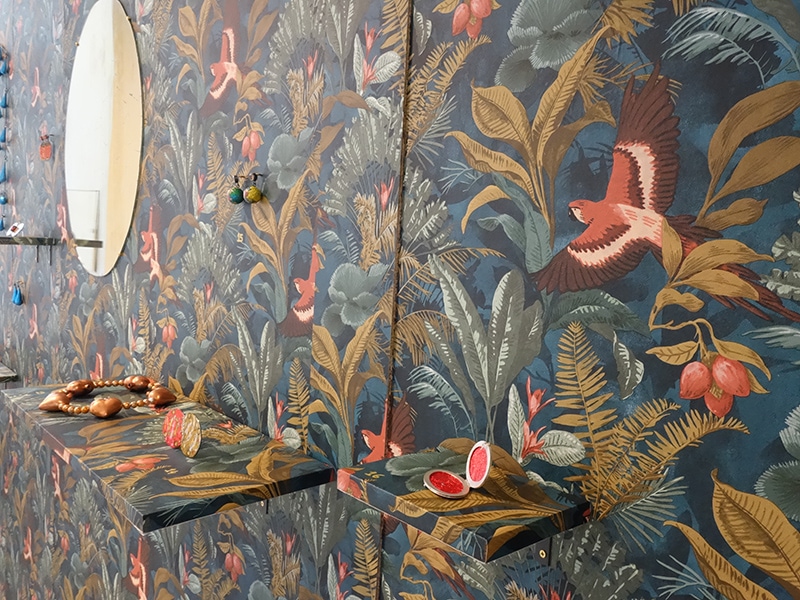
When you visit the exhibition, you immediately notice that the pieces blend in with the wallpaper, and you get the feeling that a certain horror au vacui—a horror of emptiness—persists, and there seems, in fact, to be a need to fill everything with something without leaving any empty space. According to Silva, this was on purpose, to create an intimate space. The space is attractive and fascinating, but it is not an effective exhibition strategy because it is difficult to see the pieces properly.
Work about her life is recurrent in Silva’s oeuvre, and she has already done it previously, for instance in the individual student project she produced for her graduation. That is what seems to happen in this exhibition, in which 23 pieces are displayed.

The one that first appears in front of the visitor, and that sets the tone for the theme explored in the exhibition, is about, according to Quintela, “The endless mysteries of love.” This is the only piece created in 2022. All the others were made this year. It is called Grande Ceptro do Amor (Great Scepter of Love). The ceptro, or scepter, is one of the most emblematic insignia of sovereign power, representing authority. In this jewel, the scepter is covered with beads and hearts. To create this piece, Silva made an open call on social media for hearts to be sent to her: “I NEED A LOT OF HEART PENDANTS!!”
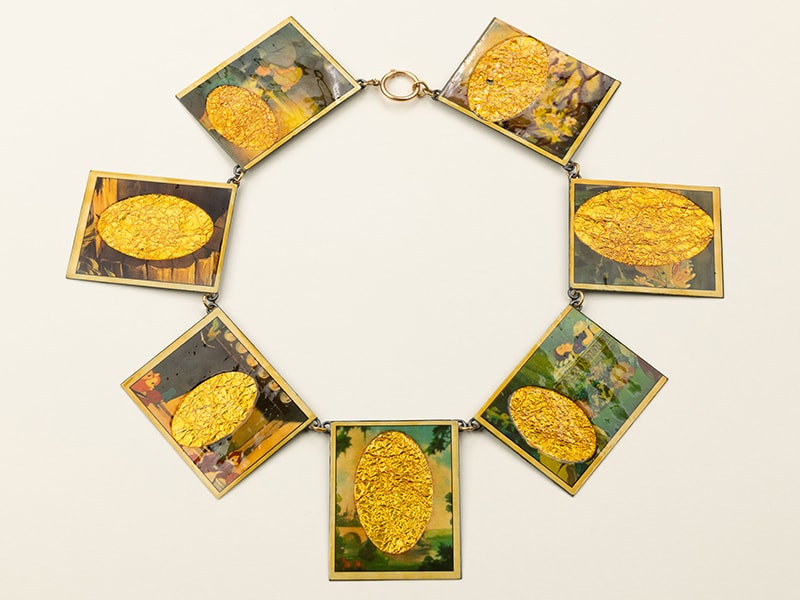
The other pieces are:
- Once upon a Time… This necklace (which gives the exhibition its name), was designed with seven old Snow White stickers, all of them with an oval-shaped chocolate wrapping paper.
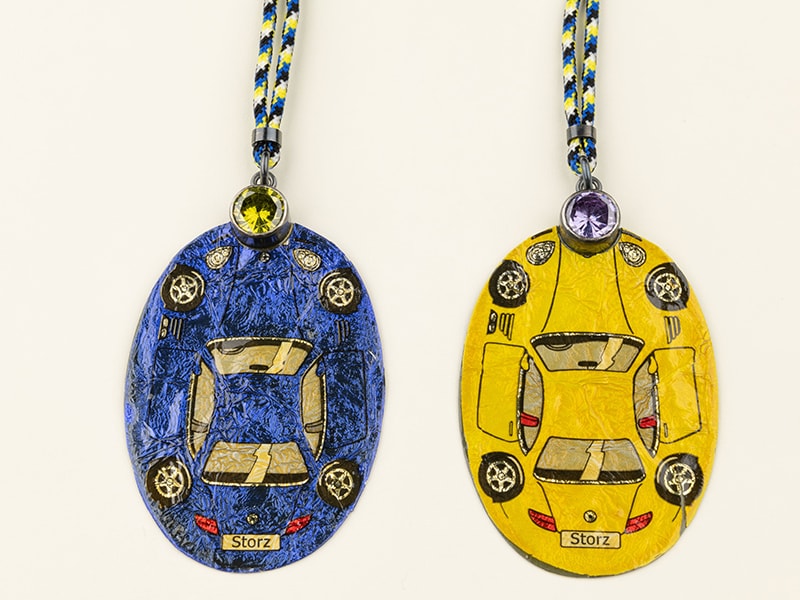
- Serge and Jane. The two pendants, made with chocolate wrapping paper in the shape of a car, inevitably lead us to think about Serge Gainsbourg’s song with Jane Birkin, Je t’aime… moi non plus, Oh, mon amour![6]
- He Has the Most Tender Eyes. A necklace with chocolate wrapping paper featuring an image of a very cute bunny.
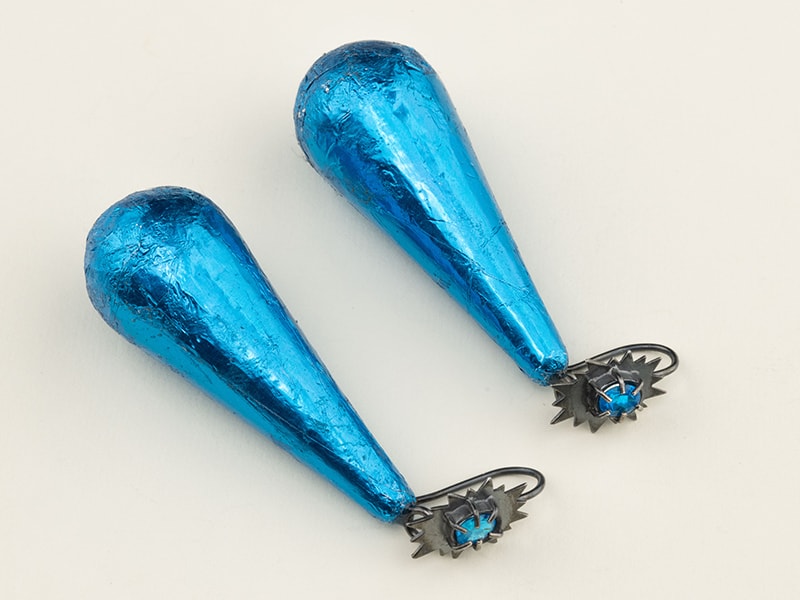
- As Time Goes By. A necklace and earrings that both use the same element: wooden teardrop-shaped pendants wrapped in blue chocolate wrapping paper.

- Quem Quer Casar com a Carochinha? A brooch and earrings that apparently allude to the story of Carochinha and João Ratão, a tale that is part of Portuguese popular culture and that ends badly, with an unhappy ending.
- Memento Mori. Three rings, a necklace, and a brooch. The title comes from Latin, meaning “remember that you must die.”[7] It foreshadows that all things have an end. The rings, made with chocolate wrapping paper in various colors and with silver, have shapes that are easily recognized and used in mourning jewelry. Mourning jewelry “served as a constant reminder to the wearer of the fragility of their own human mortality. The ring was a symbol of eternity and that comforted” the wearer.[8] The brooch is engraved with the words “Melancholy and Infinite Sadness.”

- This Heart of Mine. Another necklace with heart shapes, but for this one elements from Christmas decorations were reused.
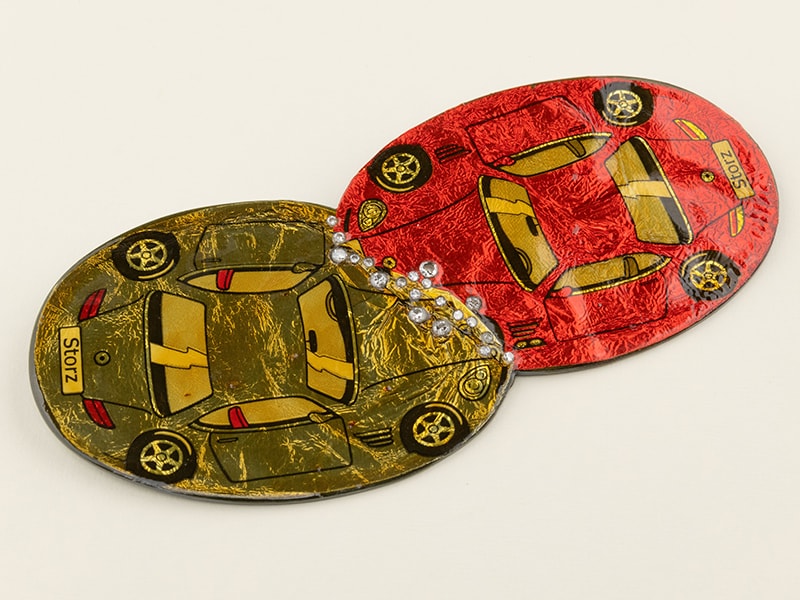
- French Kiss. A brooch designed with foil wrappers printed with images of little cars and with … bumper cars? The image of these cars is so childish that even though it is tricky to associate, it nevertheless brings to mind the 1996 movie Crash, by David Cronenberg, about car-crash victims who use cars as a liberation of sexual energy, and the accidents as a sexual stimulus.[9]

- Just Married. Earrings in the shape of two spheres with two very naïf little dolls made with chocolate wrapping paper. And isn’t the way passions are often experienced naive?
- A True Love Story. A brooch that seems to want to reveal secrets.
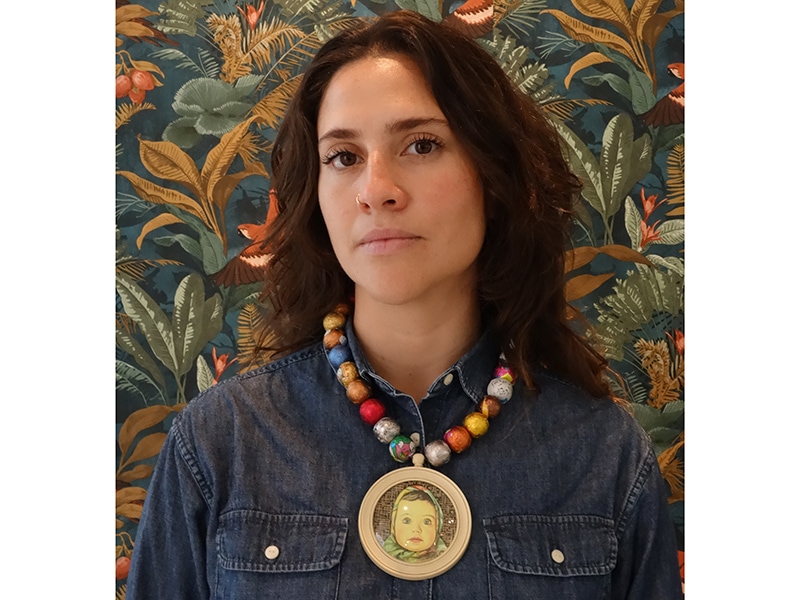
- Natasha. A necklace made with the image of the legendary Soviet chocolate Alenka.
- Leftovers. Three pins, each spherical, made with chocolate wrapping paper. A leftover is part of something, the part that has not been used.
- Mantilha. A shawl-like piece with a lot of spheres created from chocolate wrapping paper. It brings to mind the work that Silva has carried out with beads, and the potential of beads, evidenced by the curation of the exhibition Beaded, at the French Institute Munich, in 2020.

Finally, faced with a universe that invokes so many sweets, it is impossible not to remember another one of the tales collected by the Brothers Grimm, one which also involves an evil stepmother and a witch: Hansel and Gretel, in which the action centers on an attractive house covered in sweets.
In this exhibition, everything is covered with chocolate wrapping paper. To offer chocolate is a gesture of love and friendship. On the other hand, the essence of the material recurrently used in the exhibited pieces is as perishable as memory can be, and that also seems to be one of Silva’s concerns. Silva wishes to preserve mundane moments, to hold and secure memories, to immortalize them in jewelry.
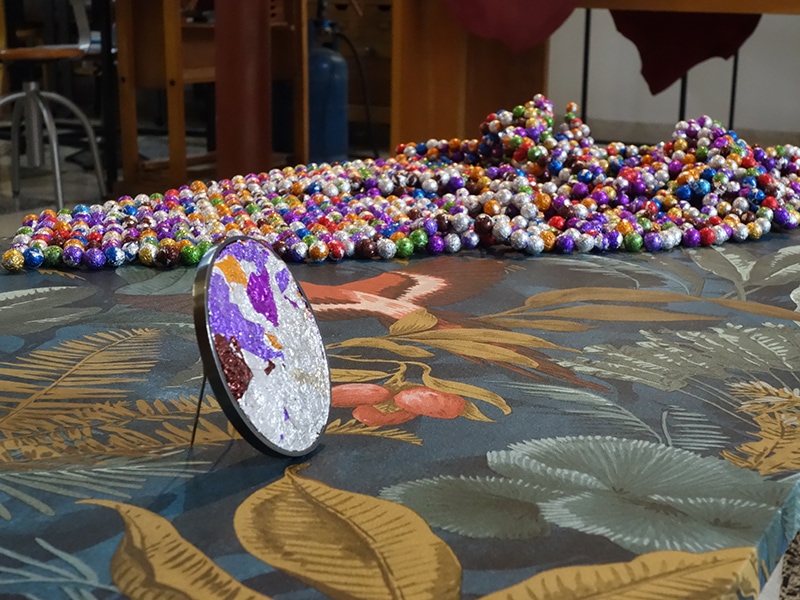
And, if the exhibition is about memory of a time that no longer returns, it is impossible not to invoke an excerpt from the poem Tabacaria, by Fernando Pessoa’s heteronym Álvaro de Campos:
Eat chocolates, little girl: Eat chocolates! See, there are no other metaphysics in the world beside chocolates. See, all religions teach no more than a candy store. Eat, dirty girl, eat! If only I could eat chocolates as truthfully as you do! But I think and, tearing the silver paper, which is really only tin foil, I drop everything on the ground, as I’ve dropped my life.[10]
© 2023 Art Jewelry Forum. All rights reserved. Content may not be reproduced in whole or in part without permission. For reprint permission, contact info (at) artjewelryforum (dot) org
Embrulhar/desembrulhar
Quando uma exposição é sobre a vida pessoal
“Once upon a time…” (era uma vez…) é assim que começam muitos contos povoados de seres mágicos e outras personagens, como príncipes e princesas, magos e feiticeiros, fadas e bruxas.
Catarina Silva vive e trabalha em Lisboa, Portugal, e faz a sua mais recente exposição individual, na Galeria Tereza Seabra, em Lisboa, exposição essa que se faz acompanhar de um texto da autora e curadora Carolina Quintela: Tudo começa com o encontro.[11] E, de acordo com esta, a exposição é sobre “os infinitos mistérios do amor, do desejo e da memória.”[12]
O cartaz que anuncia a exposição é uma imagem de Branca de Neve e os Sete Anões da Walt Disney.
Este conto foi compilado pelos irmãos Grimm, na obra Children’s and Household Tales. Esta coleção reúne muitas outras histórias folclóricas e de contos de fadas, de tradição oral, com origem na Idade Média.[13]
Outra referência que aponta para este conto na conceção da exposição é a presença de um espelho de forma oval, que, instintivamente, nos remete para a questão colocada ao espelho pela maldosa e invejosa madrasta, antagonista de Branca de Neve: “Espelho, espelho meu, existe alguém mais bela do que eu?”
O espaço da exposição, na galeria, está coberto com um papel de parede, bastante garrido, que invoca os papéis de parede de William Morris (1834-1896), uma figura chave do movimento de Arts & Crafts, movimento que teve um enorme impacto na sociedade vitoriana. Morris era um entusiasta da produção artesanal. E, na exposição, é visível o fabrico manual, percebendo-se que há uma preocupação relativa ao fazer bem tecnicamente.
Essa opção lembra também a exposição retrospetiva de Andy Warhol (1928-1987), realizada em 1971, no Whitney Museum, em Nova York, na qual o artista reutilizou papel de parede com uma vaca como fundo para as suas pinturas.
Nesse sentido, o uso e a apropriação das folhas de alumínio para chocolate bem como das imagens nelas estampadas acaba por remeter o espetador para a Pop Art, quando os artistas Pop se apropriavam de imagens da cultura popular. Também nos desperta a atenção o excesso de chocolate que foi ingerido – talvez por Catarina ou alguém próximo dela – uma vez que se torna evidente que foi necessário consumir muito chocolate para fazer as peças. Esta situação, inevitavelmente, pode ser associada à sociedade de consumo.[14]
Além disso, o facto de as folhas de alumínio para chocolate serem coloridas tornam-se bastante atrativas e, por isso, eram, e ainda são, frequentemente colecionadas. A artista portuguesa Lourdes Castro (1930-2022) também as usou no seu trabalho.[15]
Quando se visita a exposição, de imediato se constata que as peças se confundem com o papel de parede, sendo que se fica com a sensação de que perdura um certo horror au vacui, o horror ao vazio, parecendo, de facto, existir a necessidade de preencher tudo com algo, sem deixar nenhum espaço vazio.
Segundo Silva, esse foi o propósito, criar um espaço intimista, e o espaço é atrativo e fascinante, mas acaba por não ser muito funcional como estratégia expositiva porque é difícil ver as peças corretamente.
Trabalhar sobre a sua vida é recorrente na obra de Silva, que já o tinha feito anteriormente, por exemplo, no projeto individual de final de curso. É isso que parece acontecer aqui também, nesta exposição, em que são exibidas 23 peças.
A que surge primeiramente ao olhar do visitante, e que dá o mote à temática explorada na exposição, que segundo Quintela é sobre “Os mistérios infinitos do amor”, é a única concebida em 2022; todas as outras foram realizadas este ano. Trata-se de um bastão – Grande Ceptro do Amor– uma das insígnias mais emblemáticas do poder soberano, representando a autoridade.
Este bastão está coberto de missangas e corações e, para criar esta peça, Silva fez um apelo nas redes sociais para que lhe fossem enviados corações “I NEED A LOT OF HEART PENDANTS!!” (“PRECISO DE MUITOS PENDENTES EM FORMA DE CORAÇÃO!!”)
As outras peças são:
- Once Upon a Time…– colar. Esta peça (que acaba por dar nome à exposição) foi realizada com cromos antigos da Branca de Neve: sete cromos, todos eles com uma forma oval de folhas de alumínio para chocolate.
- Serge, Jane – dois pendentes, feitos com folhas de alumínio para chocolate, em forma de carro, o que nos leva, inevitavelmente, a pensar na música de Serge Gainsbourg com Jane Brikin “Je t’aime… moi non plus, Oh, mon amour!”[16]
- He Has the Most Tender Eyes – colar. Uma peça produzida com uma folha de alumínio para chocolate com a imagem de um coelhinho muito bonitinho.
- As Time Goes By – colar e brincos, sendo o mesmo elemento utilizado nas duas peças – pingentes em forma de lágrima de madeira embrulhados com folhas de alumínio para chocolate azuis.
- Quem Quer Casar com a Carochinha? – broche e brincos, numa aparente alusão à história da Carochinha e do João Ratão, história esta que faz parte da cultura popular portuguesa e que acaba mal, com um final que não é feliz.
- Memento Mori – anéis, colar e broche. O título é uma expressão latina que significa ““lembre-se de que você irá morrer”,[17] um prenúncio de que todas as coisas têm um fim. Os anéis (três) foram feitos com folhas de alumínio para chocolate de várias cores e em prata, com formas facilmente reconhecidas e usadas em Mourning Jewellery. Mourning Jewellery “served as a constant reminder to the wearer of the fragility of their own human mortality. The ring was a symbol of eternity and that comforted” the wearer.[18] O broche está gravado com as palavras “Melancholy and Infinite Sadness”.
- This Heart of Mine – colar, também com formas de corações, tendo sido, para o efeito, reutilizado um elemento de decorações natalícias.
- French Kiss – broche concebido com folhas de alumínio para chocolate, com imagens de carrinhos e diamantes. Carros de choque? A imagem destes carros é tão infantil que, embora seja difícil associar, traz à mente o filme “Crash” de 1996 de David Cronenberg, sobre vítimas de acidentes de carro que os usam como uma forma de libertação de energia sexual, e os acidentes como estímulo sexual.[19]
- Just Married – brincos, com a forma de duas esferas com dois bonequinhos muito naïfs, produzidos com folhas de alumínio para chocolate. E não é naïf (ingénua) a forma como, muitas vezes, as paixões são vividas?
- A True Love Story – broche que parece querer revelar segredos.
- Natasha – colar, feito com a imagem do lendário chocolate soviético Alyonka.
- Leftovers – três pins feitos com folhas de alumínio para chocolate cada um em forma de esfera, E uma sobra (aludida no termo leftovers) é parte de algo, a parte que não foi aproveitada.
- Mantilha – uma peça semelhante a um xaile, com imensas esferas concebidas com folhas de alumínio para chocolate, e que faz relembrar o trabalho que Silva tem realizado com missangas bem como o seu potencial, evidenciado, inclusivamente, com a curadoria da exposição BEADED, em 2020, no Instituto Francês de Munique.
Enfim, perante um universo que invoca tanta doçaria, é impossível não recordar mais um dos contos recolhidos pelos Irmãos Grimm, que igualmente envolve uma madrasta malvada e uma bruxa, Hansel and Gretel, e cuja ação se centra numa atrativa casa coberta de doces.
Na exposição, está tudo coberto com folhas de alumínio para chocolate e oferecer chocolate é um gesto de amor e amizade.
Por outro lado, a essência do material recorrentemente utilizado nas peças expostas é tão perecível como pode ser a memória e essa parece ser também para Silva uma das questões. Silva deseja preservar momentos mundanos, guardar e proteger memórias, imortalizando-as em joias.
E, se a exposição é sobre a memória de um tempo que já não volta, é impossível não invocar um excerto do poema “Tabacaria” do heterónimo de Fernando Pessoa, Álvaro de Campos.
(Come chocolates, pequena;
Come chocolates!
Olha que não há mais metafísica no mundo senão chocolates.
Olha que as religiões todas não ensinam mais que a confeitaria.
Come, pequena suja, come!
Pudesse eu comer chocolates com a mesma verdade com que comes!
Mas eu penso e, ao tirar o papel de prata, que é de folhas de estanho,
Deito tudo para o chão, como tenho deitado a vida.)[20]
© 2023 Art Jewelry Forum. All rights reserved. Content may not be reproduced in whole or in part without permission. For reprint permission, contact info (at) artjewelryforum (dot) org
[1] Read it here, in AJF’s Digital Library.
[2] “It All Begins with the Encounter,” by Carolina Quintela.
[3] See https://www.thebritishacademy.ac.uk/blog/those-saucy-grimms-fairy-tales-your-mother-never-told-you-original-first-edition-181215/.
[4] See http://ciac.ca/en/wallpapers-andy-warhol/.
[5] See https://111.pt/en/Artistas/lourdes-castro/.
[6] See https://www.independent.co.uk/arts-entertainment/music/features/jane-birkin-je-t-aime-song-serge-gainsbourg-brigitte-bardot-beyonce-a8896516.html.
[7] In Anne Louise Luthi, Sentimental Jewellery (United Kingdom: The Shire Publications Ltd., 1998), 4.
[8] In Martha G. Fales, Jewelry in America 1600-1900 (USA: Antique Collectors’ Club Ltd., 1995), 23.
[9] See https://www.batalhacentrodecinema.pt/en/filme/02-crash/.
[10] See https://irp-cdn.multiscreensite.com/12e499a6/files/uploaded/fernando-pessoa-collected-later-poems-of-alvaro-de-campos-SAMPLE.pdf.
[11] Vide https://artjewelryforum.org/library/once-upon-a-time-catarina-silva/.
[12] “Tudo começa com o encontro”, por Carolina Quintela.
[13] Vide https://www.thebritishacademy.ac.uk/blog/those-saucy-grimms-fairy-tales-your-mother-never-told-you-original-first-edition-181215/.
[14] http://ciac.ca/en/wallpapers-andy-warhol/.
[15] Vide https://111.pt/Artistas/lourdes-castro/.
[16] Vide https://www.independent.co.uk/arts-entertainment/music/features/jane-birkin-je-t-aime-song-serge-gainsbourg-brigitte-bardot-beyonce-a8896516.html.
[17] In Anne Louise Luthi, Sentimental Jewellery. United Kingdom: The Shire Publications Ltd., 1998, p. 4.
[18] In Martha G. Fales, Jewelry in America 1600-1900. USA: Antique Collectors’ Club Ltd., 1995, p. 23.
[19] Vide https://www.batalhacentrodecinema.pt/filme/02-crash.
[20] Vide http://arquivopessoa.net/textos/163.





